Compromised of 44,000 square miles of watershed, the Mobile River Basin extends from Alabama to Tennessee, Mississippi, and Georgia. The fourth-largest watershed made of primary streams in the U.S., the 45-mile-long river begins at the confluence (where two rivers meet) of the Alabama River and the Tombigbee River. A watershed, also called a drainage basin, is an area of land where all water flows toward a singular point that empties into the ocean. The Mobile River flows south and empties into Mobile Bay. From there, the water moves into the Gulf of Mexico and the Atlantic Ocean.
While it may be tempting to take a swim in this beautiful river, you’d better hold off. Let’s find out the many reasons why the Mobile River is not a safe place for swimming!
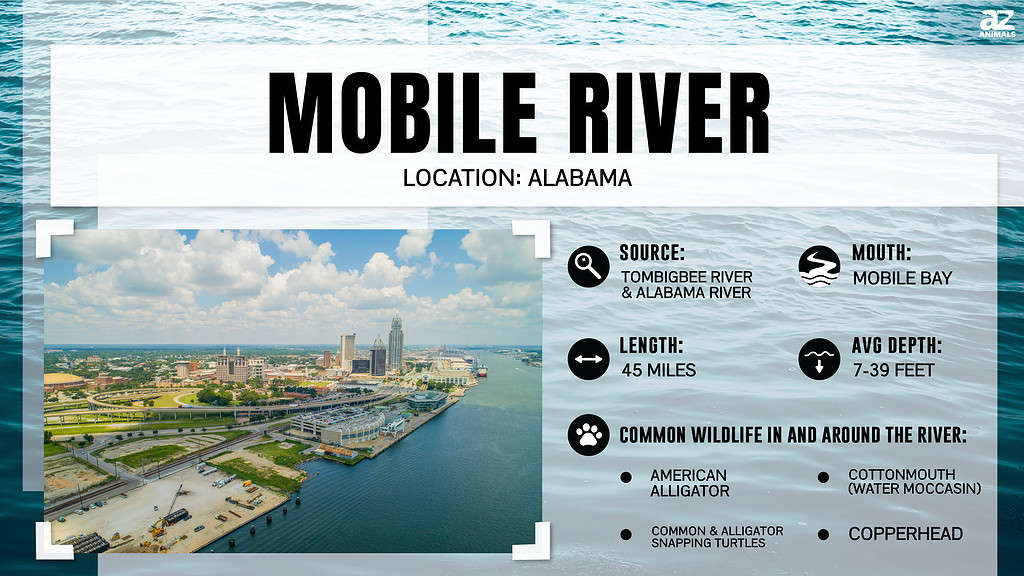
The Mobile River is absolutely beautiful, but it is not safe for swimming.
©A-Z-Animals.com/Rachael Monson
Pollution in the Mobile River
The Mobile River flows through Mobile, Alabama, in the U.S. With many industrial facilities along the river, pollution contaminates it severely. In 2022, American Rivers named this river the third most endangered river due to pollution in the United States.
The main source of pollution is coal ash from Plant Barry. Plant Barry, also known as James M. Barry Electric Generating Plant, is a coal-fired power plant. This means coal is burned to produce energy. It is one of the major power-generating facilities owned and operated by Alabama Power.
Coal ash is a dangerous contaminant because it contains radium, mercury, and arsenic, along with other dangerous chemicals and carcinogens. Carcinogens are substances that have the potential to cause cancer in living organisms, including humans. These toxins are harmful to both humans and animals that rely on this water to live. Fish, crawfish, and other food animals absorb them. The people who eat the fish then intake them, too. Swimming in the Mobile River could result in soaking up these chemicals through your skin. Not only that, but some people accidentally or intentionally drink the river water containing these toxins. The land animals in the area also drink the contaminated water.

Coal-fired power plants release chemicals and hard metals into the surrounding rivers.
©alexeys/iStock via Getty Images
Animals In and Around the Mobile River
If the extreme pollution of the Mobile River doesn’t scare you away from swimming there, the number of dangerous animals in and around the river should. Home to a myriad of snakes, snapping turtles, and even alligators, this river is very dangerous for would-be swimmers and even those fishing from the bank.
Snakes
Many species of snakes inhabit the water and shores of the Mobile River. A bite from any of these snakes is painful, though not all of them are venomous.
The most concerning of these species, the cottonmouth, delivers an extremely painful and highly venomous bite. Also called water moccasins, these snakes swim and hunt in the water and along the banks of the river. Females give birth to live young that can grow large enough to eat baby alligators. The name cottonmouth comes from the snake’s threat display, involving opening its mouth wide and showing its fangs. Their venom kills within hours if not treated.
Copperhead snakes make their home around the river bank, too, especially in wooded areas. The bite of this snake causes severe and immediate swelling along with bruising and intense pain. Though deaths from copperhead bites are rare, they can kill if treatment is not received in a timely manner.
Another snake found in the Mobile River is the diamond-backed water snake. While non-venomous, their bite is extremely painful. The midland water snake also behaves aggressively if harassed or stepped on.
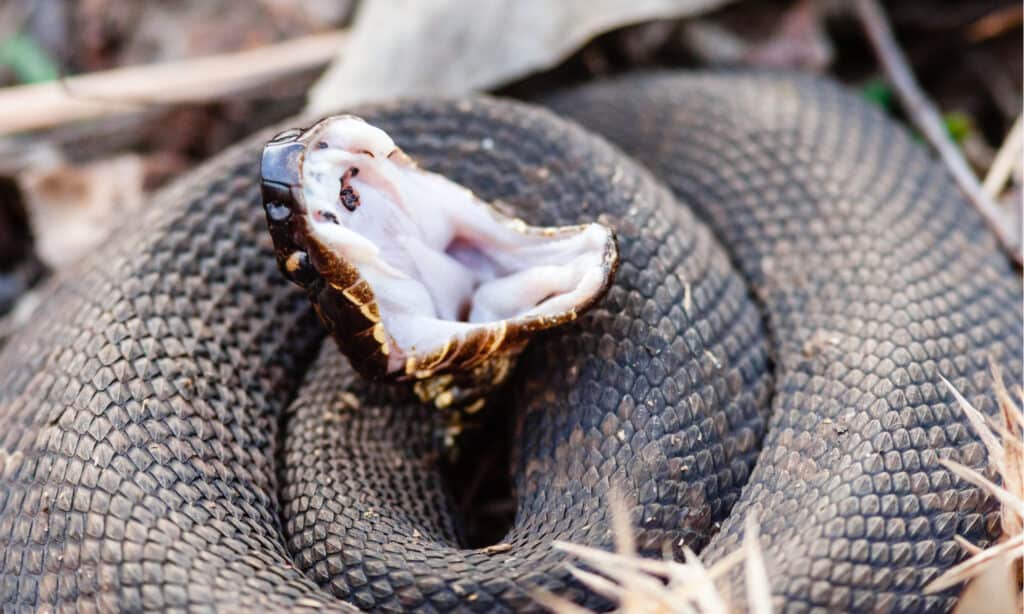
Cottonmouths perform a threat display, opening their mouths wide to show their fangs.
©Marcum Havens/Shutterstock.com
Snapping Turtles
Two types of snapping turtles frequent the waters of the Mobile River. The common snapping turtle and the alligator snapping turtle, often called snappers, both make the river their home. Both snapper species are dangerous to humans, with a bite strong enough to sever human fingers or toes from the body.
The common snappers grow up to 23 pounds and possess a bite force of 147 pounds per square inch (psi). That’s about the same as a beagle or corgi. Dog bites inflict significant damage, regardless of their size. In contrast, the alligator snapper grows up to 175 pounds with a bite force of 1,000 psi. That’s just 100 psi less than a spotted hyena, which routinely chews through the bones of large herd animals! Both of these turtles can be aggressive, especially when defending their territory or nesting areas. They also may mistake your fingers or toes for fish they normally eat.

Alligator snapping turtles are massive, with huge mouths, strong jaws, and very sharp beaks.
©Sista Vongjintanaruks/Shutterstock.com
American Alligators
Another major danger with swimming in the Mobile River is the American alligator. Females aggressively protect their nest sites and their hatchlings. Nesting season in late spring and early summer is the most common time for attacks, as this is also when humans are most likely to enter the area and swim.
A surprised alligator may react with a bite. Though not directly aggressive toward humans, they commonly bite first as a defense mechanism. If you were to bump the side of a resting alligator’s jaw while swimming, it may swing its head and bite down to ensure its own safety.
These predators have a bite force of 2125 psi. That’s double the force of the alligator snapping turtle. Imagine the damage a bite from an alligator causes! Even if a person manages to escape, the injuries sustained can cause lifelong problems or even death due to blood loss.
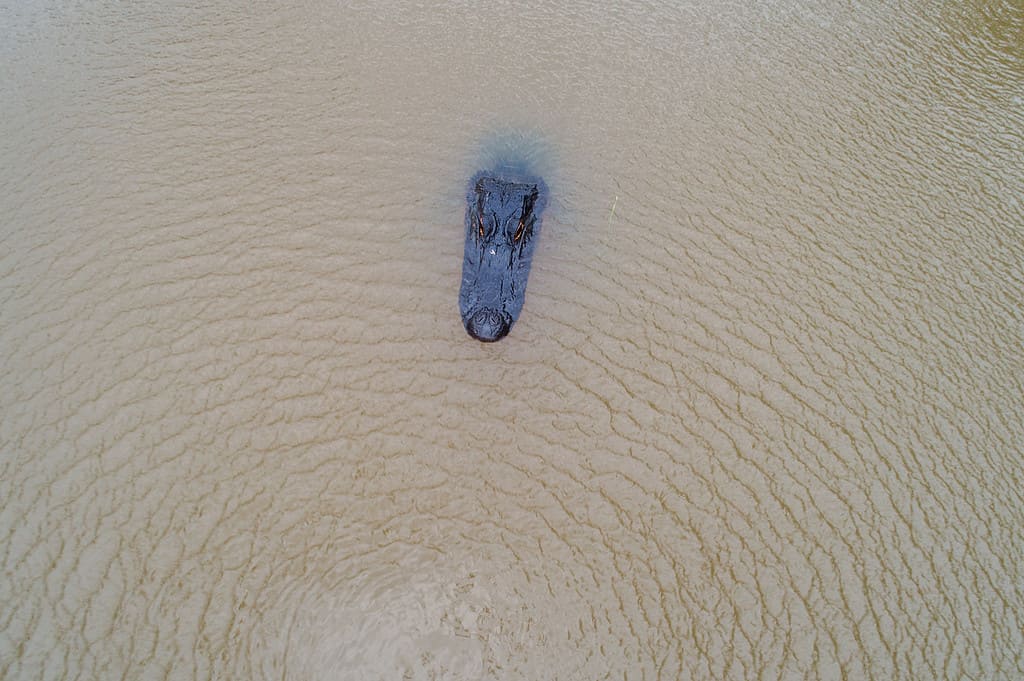
The American alligator inhabits lakes, rivers, and marshes throughout the Southeastern United States.
©George Dodd/iStock via Getty Images
Other Concerning Animals
As if the animals we talked about before weren’t enough to terrify you, the Mobile River and its banks also house many other dangerous creatures. These include biting insects and spiders, wild hogs, and even sharks. You’re unlikely to encounter sharks unless swimming near the mouth of the river and the Gulf of Mexico, but the concern is still very real.
Two of the most venomous spiders in Alabama, the Brown recluse and the black widow, build their webs and reproduce around the moist banks and wooded areas near the river.
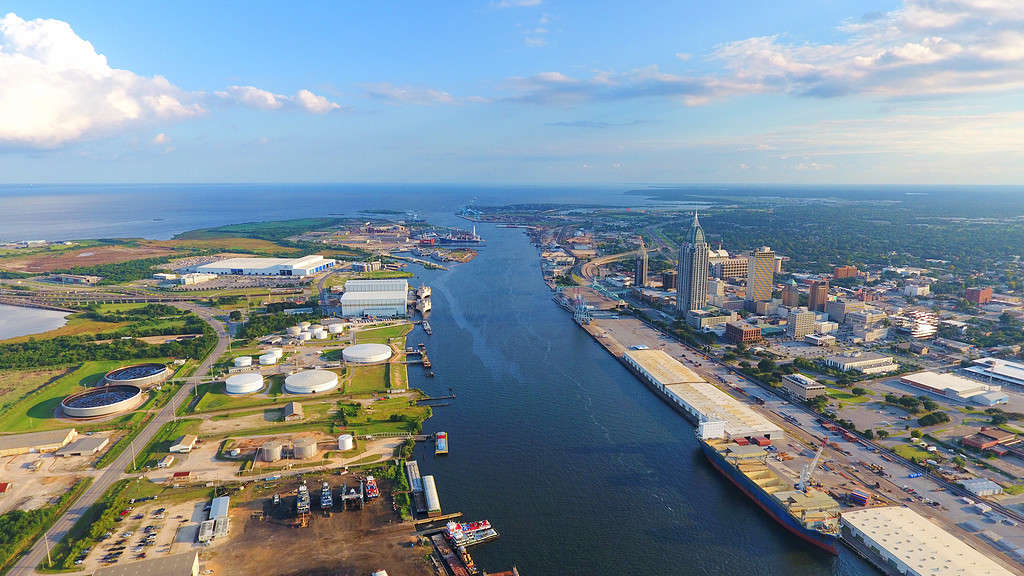
Boat traffic is common in the Mobile River around the Port of Mobile.
©George Dodd/iStock via Getty Images
Other Reasons Not to Swim in the Mobile River
Other reasons not to swim in this river (or any river) include the depth of the river and the speed at which the water moves. Another concern is the huge amount of boat traffic in the area. Boaters may not see someone swimming in the water. This could easily lead to injuries and drowning. In 2019 alone, 12 people died from boating accidents in the Mobile River and Mobile Bay.
Depth of the Mobile River
The average depth of the Mobile River is 23 feet. That’s about as deep as a common shipping container is long. Some parts of the river are even deeper, as much as 39 feet deep! The deep water makes for a good home for the many creatures that live there. The deeper the water, the harder to see into it, as well. This makes it difficult to determine if you are safe from attacks.
Speed of the Mobile River
The surface speed (or velocity) of moving water is difficult to measure. However, the flow rate (how much volume of water moves in a given time frame) of the Mobile River is 64,000 cubic feet per second (ft³/s). After doing some complicated math, we calculated that the average speed of the river is about 3.1 miles per hour (mph). The Mobile River is considered fast-moving with strong currents. Generally, after heavy rains, rivers can increase in velocity by over 10 feet per second (fps). That’s equal to about 6.8 mph. That means the water may be moving nearly 10 mph. The average adult human can only swim 2.5-3.5 mph. Therefore, a human could be in real trouble trying to swim in the Mobile River.
Width of the Mobile River
The Mobile River ranges anywhere from 20 feet to 16 miles wide! The average width is eight miles. Trying to swim from one side to the other could result in exhaustion. Swift currents beneath the water’s surface can also pull someone under and result in drowning. The longer a person swims, the more likely they are to encounter these dangers.
Where is the Mobile River?
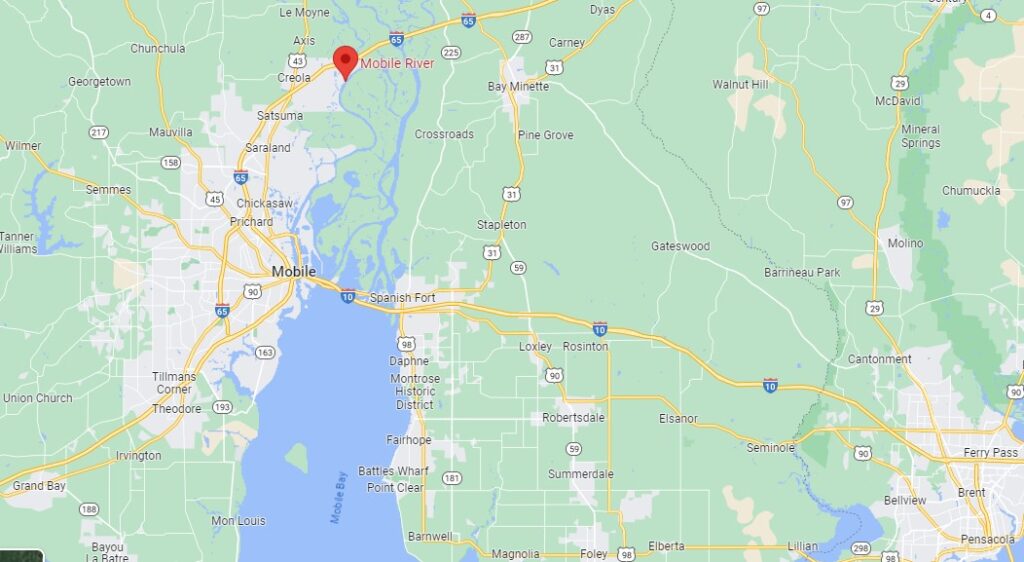
The Mobile River flows into Mobile Bay and then to the Gulf of Mexico.
©A-Z-Animals.com/Rachael Monson
The photo featured at the top of this post is © felixmizioznikov/iStock via Getty Images
Thank you for reading! Have some feedback for us? Contact the AZ Animals editorial team.







